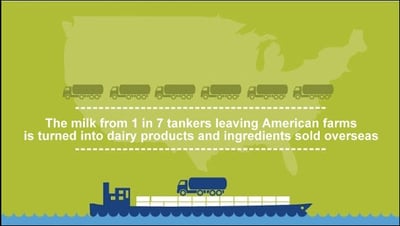This is a teachable moment to tell the positive story of U.S. dairy exports, but we need the efforts of everyone in the industry to get the message out.
Since taking over as the U.S. Dairy Export Council’s president and CEO last month, Tom Vilsack has criss-crossed the country meeting people and giving speeches.
Interest in the former U.S. Agriculture Secretary’s perspective has been keen. Exports, imports, free-trade agreements and their impact on the U.S. economy have been in the news, with politicians, activists, journalists and others voicing strong opinions about U.S. trade policy.
To break through the noise, or as Vilsack puts it, “punch above our weight,” the U.S. dairy industry needs to convey a clear and consistent message, not just on trade policy, but on a host of other issues.
“We have to collaborate,” Vilsack said in a speech at the International Dairy Foods Association’s Dairy Forum. “We have to communicate. We have to cooperate.”
Vilsack isn’t just referring to the leading dairy organizations.
“It is important and necessary for everyone in the supply chain that is impacted and is affected by dairy—whether they produce it, process it, package it, transport it, sell it, market it or promote it—to speak as best we can with a single unified voice on a variety of issues so that we can impact and affect positive policymaking.”
To that end, below are seven shareable facts about U.S. dairy exports.
Help us communicate our positive story by sharing with family, friends, neighbors and elected officials, both offline and online. If you use Twitter, click the blue bird to easily share a ready-made tweet.
1. U.S. dairy exports create jobs.
 Most people know American agriculture feeds much of the world. What some don’t realize is agriculture exports create thousands of jobs right here in America. The USDA estimates that at the dairy farm level, each $1 billion of U.S. dairy exports generates more than 20,000 jobs and almost $3 billion of economic output. At the manufacturing level, USDA calculates that U.S. dairy exports support approximately 3,200 jobs per $1 billion of exports. Last year, U.S. dairy exports generated more than 110,000 American jobs in dairy farming, manufacturing and related sectors. To put that into perspective, that’s roughly equal to the number of employees at Apple.
Most people know American agriculture feeds much of the world. What some don’t realize is agriculture exports create thousands of jobs right here in America. The USDA estimates that at the dairy farm level, each $1 billion of U.S. dairy exports generates more than 20,000 jobs and almost $3 billion of economic output. At the manufacturing level, USDA calculates that U.S. dairy exports support approximately 3,200 jobs per $1 billion of exports. Last year, U.S. dairy exports generated more than 110,000 American jobs in dairy farming, manufacturing and related sectors. To put that into perspective, that’s roughly equal to the number of employees at Apple.
2. The world needs U.S. dairy exports.
Many countries don’t have the cows, farms, natural resources, technology and other capabilities required to meet the dairy needs of their own citizens. They have to look elsewhere. For many, this country is the best choice. U.S. dairy exports have more than quadrupled over the last 16 years, from less than $1 billion in 2000 to nearly $5 billion in 2016.
3. Milk from one in seven U.S. tankers ends up in products and ingredients overseas.

Fifteen years ago we were exporting roughly 5% of U.S. milk production. Today we’re at nearly three times that level, even as overall U.S. milk production has continued to grow. The milk in one out of seven tankers leaving American farms ends up in dairy products and ingredients sold overseas. That makes dairy exports integral to the health of the U.S. dairy industry.
4. We’re shipping “whey” more than milk.
Mention U.S. dairy exports to someone not familiar with our industry and they probably envision gallons of fluid milk on a cargo container heading to China. While we do export some milk, (with long shelf life) to China, most of our exports are milk-based products and ingredients. U.S. dairy exporters shipped 1.89 million tons of milk powders, whey products, lactose, cheese and butterfat last year, up 3% from 2015’s level.
5. Exports of U.S. dairy ingredients are surging.
 In 2016, U.S. dairy exports were not led by delicious products, like cheese, but nutritious ingredients, like whey protein. In fact, 62% of the $4.7 billion in U.S. dairy exports last year were dairy ingredients, with variations of whey the rising star. You can think of dairy ingredients as the protein-packed food that goes into all sorts of recipes to create all sorts of food all around the world, ranging from pancake mix with whey protein, pizza dough with sweet whey powder and protein ice cream. Unfortunately, surveys show most Americans don’t even know whey comes from dairy. Perhaps you can set them straight.
In 2016, U.S. dairy exports were not led by delicious products, like cheese, but nutritious ingredients, like whey protein. In fact, 62% of the $4.7 billion in U.S. dairy exports last year were dairy ingredients, with variations of whey the rising star. You can think of dairy ingredients as the protein-packed food that goes into all sorts of recipes to create all sorts of food all around the world, ranging from pancake mix with whey protein, pizza dough with sweet whey powder and protein ice cream. Unfortunately, surveys show most Americans don’t even know whey comes from dairy. Perhaps you can set them straight.
6. U.S. dairy exports can literally make the world taller.
We all know milk builds big muscles. But it also provides nutrition for children in countries like Guatemala, Sudan and Vietnam. Since the United States started exporting dairy products in large quantities, child stunting, a form of malnutrition, has declined 22 percent in developing countries. U.S. dairy exports are literally lifting the stature of children. Many countries see dairy as a key to their nation’s health. Vietnamese men and women are among the shortest in the world; the average man is 5’4″ and the average woman is 5’1″. At the same time, Vietnam spends more on health care as a percent of GDP than any country in the region. As part of a comprehensive plan, the government has set a goal to increase average heights by 1-2″ by 2020. The primary means for accomplishing this is through increased milk consumption.
7. Mexico is our most important market and job creator.
 Mexico is not only our neighbor to the south. It’s the largest importer of our dairy products, buying one-fourth of everything we exported. This means Mexican buyers support about 30,000 American jobs, primarily in rural America. It takes the equivalent of roughly 1,500 average-sized U.S. dairy farms to supply the volume of milk we ship to Mexico in the form of various dairy products—that’s a lot of farm families relying on the continued free flow of U.S. dairy products to Mexico. Since the North American Free Trade Agreement (NAFTA) became law in 1994, U.S. dairy exports to Mexico have increased from $250 million to $1.2 billion.
Mexico is not only our neighbor to the south. It’s the largest importer of our dairy products, buying one-fourth of everything we exported. This means Mexican buyers support about 30,000 American jobs, primarily in rural America. It takes the equivalent of roughly 1,500 average-sized U.S. dairy farms to supply the volume of milk we ship to Mexico in the form of various dairy products—that’s a lot of farm families relying on the continued free flow of U.S. dairy products to Mexico. Since the North American Free Trade Agreement (NAFTA) became law in 1994, U.S. dairy exports to Mexico have increased from $250 million to $1.2 billion.
Source: U.S. Dairy Export Council









